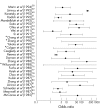The causal relation between human papillomavirus and cervical cancer
- PMID: 11919208
- PMCID: PMC1769629
- DOI: 10.1136/jcp.55.4.244
The causal relation between human papillomavirus and cervical cancer
Abstract
The causal role of human papillomavirus infections in cervical cancer has been documented beyond reasonable doubt. The association is present in virtually all cervical cancer cases worldwide. It is the right time for medical societies and public health regulators to consider this evidence and to define its preventive and clinical implications. A comprehensive review of key studies and results is presented.
Figures










Comment in
-
Cervical cancer.J Clin Pathol. 2002 Apr;55(4):241-2. doi: 10.1136/jcp.55.4.241. J Clin Pathol. 2002. PMID: 11919206 Free PMC article. No abstract available.
References
-
- Peto R, zur Hausen H, eds. Viral origin of cervical cancer. Bambury report no. 21, New York: Cold Spring Harbor CSH Press, 1986.
-
- Franco EL. The sexually transmitted disease model for cervical cancer: incoherent epidemiologic findings and the role of misclassification of human papillomavirus infection. Epidemiology 1991;2:98–106. - PubMed
-
- Bosch FX, Muñoz N, de Sanjosé S, et al. Risk factors for cervical cancer in Colombia and Spain. Int J Cancer 1992;52:750–58. - PubMed
-
- Schiffman MH, Bauer HM, Hoover RN, et al. Epidemiologic evidence showing that human papillomavirus infection causes most cervical intraepithelial neoplasia. J Natl Cancer Inst 1993;85:958–64. - PubMed
-
- Thomas DB, Ray RM, Koetsawang A, et al. Human papillomaviruses and cervical cancer in Bangkok. I. Risk factors for invasive cervical carcinomas with human papillomavirus types 16 and 18 DNA. Am J Epidemiol 2001;153:723–31. - PubMed
Publication types
MeSH terms
Substances
LinkOut - more resources
Full Text Sources
Other Literature Sources
Medical
